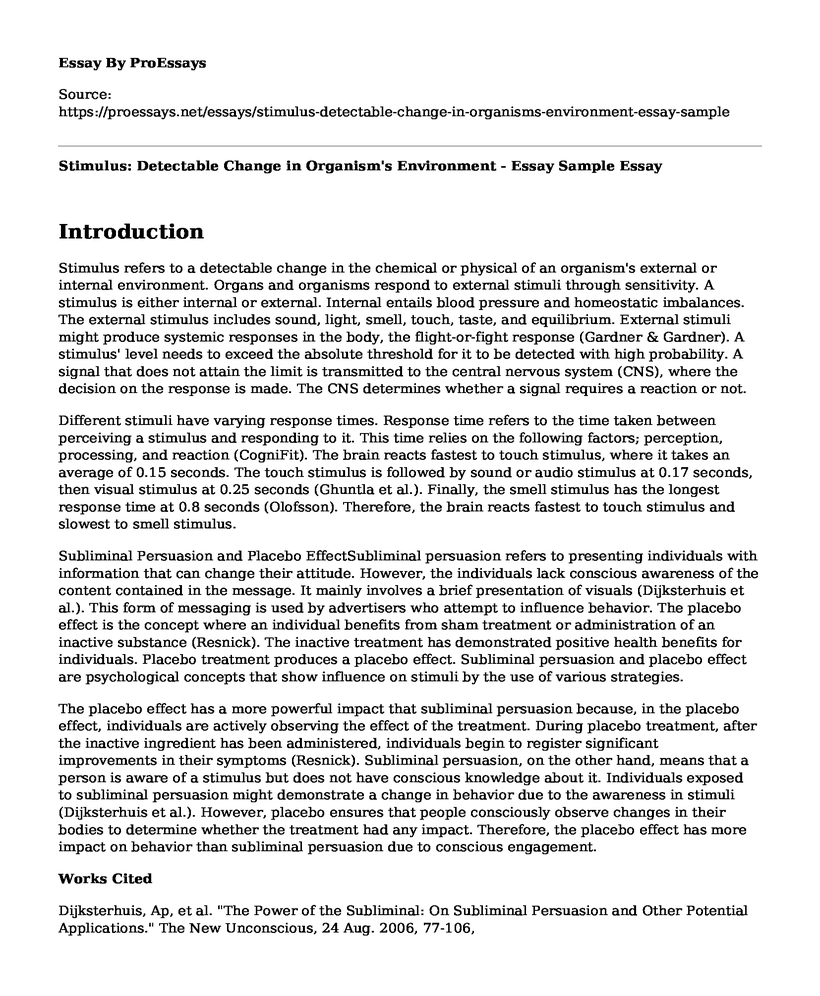Introduction
Stimulus refers to a detectable change in the chemical or physical of an organism's external or internal environment. Organs and organisms respond to external stimuli through sensitivity. A stimulus is either internal or external. Internal entails blood pressure and homeostatic imbalances. The external stimulus includes sound, light, smell, touch, taste, and equilibrium. External stimuli might produce systemic responses in the body, the flight-or-fight response (Gardner & Gardner). A stimulus' level needs to exceed the absolute threshold for it to be detected with high probability. A signal that does not attain the limit is transmitted to the central nervous system (CNS), where the decision on the response is made. The CNS determines whether a signal requires a reaction or not.
Different stimuli have varying response times. Response time refers to the time taken between perceiving a stimulus and responding to it. This time relies on the following factors; perception, processing, and reaction (CogniFit). The brain reacts fastest to touch stimulus, where it takes an average of 0.15 seconds. The touch stimulus is followed by sound or audio stimulus at 0.17 seconds, then visual stimulus at 0.25 seconds (Ghuntla et al.). Finally, the smell stimulus has the longest response time at 0.8 seconds (Olofsson). Therefore, the brain reacts fastest to touch stimulus and slowest to smell stimulus.
Subliminal Persuasion and Placebo EffectSubliminal persuasion refers to presenting individuals with information that can change their attitude. However, the individuals lack conscious awareness of the content contained in the message. It mainly involves a brief presentation of visuals (Dijksterhuis et al.). This form of messaging is used by advertisers who attempt to influence behavior. The placebo effect is the concept where an individual benefits from sham treatment or administration of an inactive substance (Resnick). The inactive treatment has demonstrated positive health benefits for individuals. Placebo treatment produces a placebo effect. Subliminal persuasion and placebo effect are psychological concepts that show influence on stimuli by the use of various strategies.
The placebo effect has a more powerful impact that subliminal persuasion because, in the placebo effect, individuals are actively observing the effect of the treatment. During placebo treatment, after the inactive ingredient has been administered, individuals begin to register significant improvements in their symptoms (Resnick). Subliminal persuasion, on the other hand, means that a person is aware of a stimulus but does not have conscious knowledge about it. Individuals exposed to subliminal persuasion might demonstrate a change in behavior due to the awareness in stimuli (Dijksterhuis et al.). However, placebo ensures that people consciously observe changes in their bodies to determine whether the treatment had any impact. Therefore, the placebo effect has more impact on behavior than subliminal persuasion due to conscious engagement.
Works Cited
Dijksterhuis, Ap, et al. "The Power of the Subliminal: On Subliminal Persuasion and Other Potential Applications." The New Unconscious, 24 Aug. 2006, 77-106, https://www.researchgate.net/publication/46667196_The_Power_of_the_Subliminal_On_Subliminal_Persuasion_and_Other_Potential_Applications/citation/download. Accessed 9 Mar 2020.
Gardner, R. Allen, and Beatrix Gardner. The Structure of Learning: From Sign Language to Stimuli. Psychology Press, 2013.
Ghuntla, Tejas, et al. "A comparison and importance of auditory and visual reaction time in basketball players." Saudi Journal of Sports Medicine. Vol. 14 no.1, 2014, http://www.sjosm.org/article.asp?issn=1319-6308;year=2014;volume=14;issue=1;spage=35;epage=38;aulast=Ghuntla. Accessed 9 Mar 2020.
Olofsson, Jonas. "Time to smell: a cascade model of human olfactory perception based on response-time (RT) measurement." Frontiers in Psychology vol. 5, no. 33, 4 Feb. 2014, https://www.ncbi.nlm.nih.gov/pmc/articles/PMC3912348/. Accessed 9 Mar. 2020.
Resnick, Brian. "The weird power of the placebo effect explained." Vox. 7 Jul. 2017, https://www.vox.com/science-and-health/2017/7/7/15792188/placebo-effect-explained. Accessed 9 Mar 2020.
"Response Time or Reaction Time- Cognitive Ability." CogniFit, 17 Jan. 2017, www.cognifit.com/science/cognitive-skills/response-time. Accessed 9 Mar 2020.
Cite this page
Stimulus: Detectable Change in Organism's Environment - Essay Sample. (2023, Apr 23). Retrieved from https://proessays.net/essays/stimulus-detectable-change-in-organisms-environment-essay-sample
If you are the original author of this essay and no longer wish to have it published on the ProEssays website, please click below to request its removal:
- Remaking Nature Essay Example
- Biodiversity Loss Essay Example
- Anatomy and Physiology-Myocardial Infarction
- Research Paper on Endangered Species Act
- Essay on Illegal Hunting & Trade of Endangered Species in Africa: Causes & Consequences
- The Gluteus Maximus: A Powerful Muscle for Upright Posture - Essay Sample
- Digestive System: Anatomy & Physiology - Essay Sample







